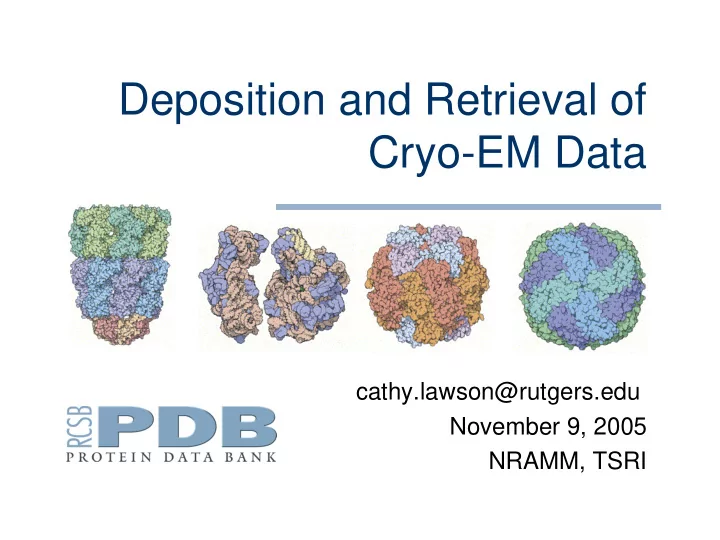

Deposition and Retrieval of Cryo-EM Data cathy.lawson@rutgers.edu November 9, 2005 NRAMM, TSRI
Growth of Coordinate Entries Number of released coordinate entries Year
Growth of EM Entries kelp fly virus 150 August 2005 EM coordinate entries, PDB EM map entries, EMDB acetylcholine receptor 100 Number of Entries 70S ribosome 50 rhinovirus-receptor complex recA hexamer bacteriorhodopsin 0 1990 1995 2000 2005 Year
How to deposit/retrieve EM data PDB Archive @wwPDB centers • Coordinates • Structure Factors • Information about the experiments (meta data) EM Database @MSD-EBI • Maps + • Slices, Masks, Structure Factors, Layerlines, Images, Fourier Shell Correlation Curve • Information about the experiments (meta data)
Two deposition steps? I could DO more experiments if it were easier to ARCHIVE them…
Archiving Meta Data Example: T4 bacteriophage baseplate PDB 1TJA, EMD 1086 22 33 23 collected collected by collected by Both EMDB and PDB by EMDB PDB only only Total EM-related meta data items = 78
Two retrieval steps? How can I look at the EM map AND coordinates of this molecule together?
Typical EM data Viewing Problems Map has Map is in different incorrect scale reference frame EMD_1060 1UF2 2BK2 EMD_1106 Rice Dwarf Virus Pneumolysin Prepore Complex
Improving the situation Cryo-EM Deposition Workshop @ Rutgers, 2004 Develop comprehensive meta data dictionary Create “One-stop-shop” for deposition/retrieval of cryo-EM data
Oct 2004 Workshop
March 2005 Cryo-EM Dictionary Biochemical EM Data Collection EM Specimen Sample Preparation Preparation em_imaging Description em_sample_preparation em_vitrification em_assembly em_detector em_sample_support em_stain em_image_scans em_entity_assembly em_array_formation em_cryo_stain em_entity_assembly_list em_microscope em_solution_composition em_embedding_agent em_micrographs em_virus_entity em_electron_diffraction em_icos_virus_shells Structure Image Processing em_electron_diffraction_phase em_single_particle Analysis em_singleparticle_selection em_electron_diffraction_pattern em_filaments em_3d_fitting em_3d_reconstruction em_2d_crystal em_3d_fitting_list New categories em_particle_picking em_classes recommended at em_particle_picking_list em_refinement the Oct 2004 em_filament_selection workshop em_fsc_curve em_filament_reconstruction are in pink
Cryo-em definition development http://rcsb-cryo-em_development.rutgers.edu/ web site
cryoEM Dictionary Examples
Cryo-EM Dictionary • 521 data items http://mmcif.pdb.org/dictionaries/mmcif_em.dic/Index
EM data representation issues Coordinate Format Symmetry Visualization
Coordinate Format PDB format • maximum of 99,999 atoms, 62 chains • larger structures represented in multiple files mmCIF/PDBML formats • no restrictions on size • mmCIF recognized by many crystallography applications • use is strongly encouraged for current/future software applications http://mmcif.rcsb.org/, http://pdbml.rcsb.org/
Format Examples mmCIF PDBML loop_ <PDBx:atom_site id="2168"> _atom_site.id <PDBx:group_PDB>ATOM</PDBx:group_PDB> _atom_site.label_atom_id <PDBx:type_symbol>C</PDBx:type_symbol> _atom_site.label_comp_id <PDBx:label_atom_id>C</PDBx:label_atom_id> _atom_site.label_asym_id <PDBx:label_alt_id xsi:nil="true" /> _atom_site.label_seq_id _atom_site.Cartn_x <PDBx:label_comp_id>PRO</PDBx:label_comp_id> _atom_site.Cartn_y <PDBx:label_asym_id>F</PDBx:label_asym_id> _atom_site.Cartn_z 1 O5* G A 1 -3.897 61.994 -24.841 <PDBx:label_entity_id>2</PDBx:label_entity_id> 2 C5* G A 1 -5.016 62.932 -24.76 <PDBx:label_seq_id>5</PDBx:label_seq_id> <PDBx:Cartn_x>-9.306</PDBx:Cartn_x> <PDBx:Cartn_y>-17.809</PDBx:Cartn_y> <PDBx:Cartn_z>14.947</PDBx:Cartn_z> <PDBx:occupancy>0.50</PDBx:occupancy> <PDBx:B_iso_or_equiv>25.40</PDBx:B_iso_or_equiv> <PDBx:auth_seq_id>6</PDBx:auth_seq_id> <PDBx:auth_comp_id>PRO</PDBx:auth_comp_id> <PDBx:auth_asym_id>B</PDBx:auth_asym_id> <PDBx:auth_atom_id>C</PDBx:auth_atom_id> <PDBx:pdbx_PDB_model_num>1</PDBx:pdbx_PDB_model_n um> </PDBx:atom_site>
Symmetry Asymmetric Unit Biological Unit Non-trivial problem to provide a correct set of transformations and a procedure for applying them We are investigating ways to better standardize this process Full biological units are available from the RCSB-PDB Rice biological Dwarf unit Virus asymmetric unit
Visualization AstexViewer development version, EBI For Non-experts: • free software • multiple platforms • no browser dependence • easy to install and use • user-friendly interface
Acknowledgements Rutgers RCSB-PDB Helen Berman John Westbrook RCSB Annotator Team European Bioinformatics Institute Kim Henrick Baylor College of Medicine Wah Chiu Matt Baker NIGMS
Recommend
More recommend